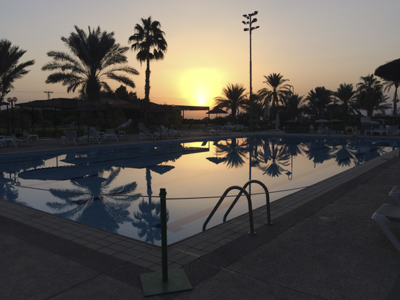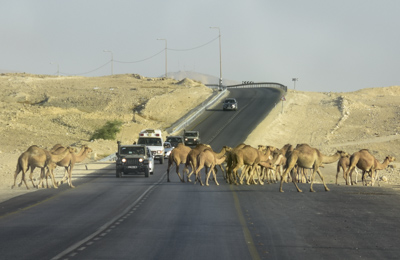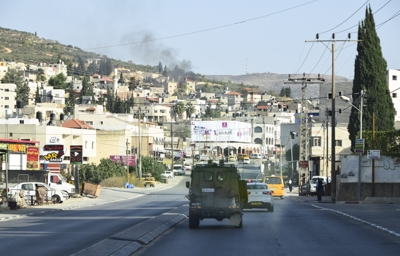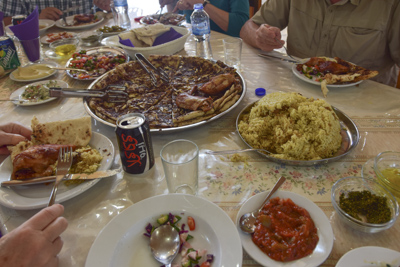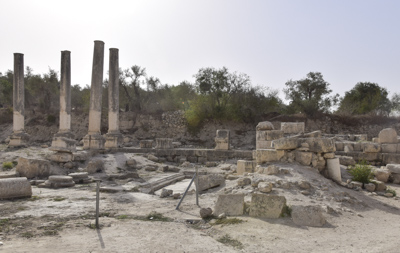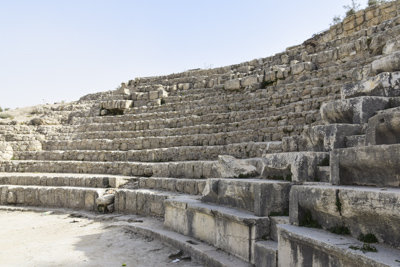Thursday – October 19, 2017
We had to have an early start because we had a full schedule planned for today. That’s my photo of the sun rising over the pool at the Jericho Resort Village. After breakfast we drove north to the city of Nablus, whose biblical name was Shechem.
Our first stop in Nablus was to see Jacob’s Well which is located within the Greek Orthodox Church of St. Photini at Bir Ya’qub. By 330 AD, this site had been identified as the place where Jesus held a conversation with a Samaritan woman. The first church was built over the site in 384 AD. Several other churches were built and destroyed over the centuries.
In 1860, the site was obtained by the Greek Orthodox church and a new church, dedicated to St. Photini the Samaritan, was built along with a monastery. An earthquake destroyed the building in 1927.
Father Ioustinos led a major reconstruction project to rebuild the church and restore Jacob’s Well in a crypt on a lower level.
Jacob’s Well is accessed by entering the church and descending stairs to the crypt where the well is located. There is a winch with a handle and a bucket to draw water.
A group of Greek monks and other tourists arrived and the priests conducted a service in the sanctuary.
We left the church and drove to the center of Nablus, an ancient city located in a narrow valley between two mountains. There are about 150,000 inhabitants in Nablus. The city is a Palestinian commercial and cultural center, containing a large university and the Palestinian stock-exchange. We walked into a huge souq or market.
We left the market and crossed the busy intersection to a commercial street. Hisham pointed out the Touqan Soap Factory which made soap using virgin olive oil, water and an alkaline sodium compound. The finished soap is ivory-colored and has almost no scent.
The ingredients of “Nabulsi” soap are heated in large copper vats and stirred continuously for eight days. The liquid soap was spread evenly on the floor of the factory. After it is set, the soap was cut into cubes and dried, for months, by stacking them in a high “cone” to allow air to circulate around the cubes.
The floor of the factory was waxy and slippery and a little scary to walk on. We left and walked to the next corner of the busy city.
Hisham directed us to a neighborhood bakery called Abu Salha Sweets and ordered knafe – an Arab pastry made with cheese. My guide book said the knafe in Nablus is “the best you will ever eat.”
Fortified with knafe, we boarded the bus and drove up a steep road up to the top of Mount Gerizim which is home to the last remaining community of Samaritans. There are only 400 Samaritans left and they continue to practice some of the region’s strictest and most ancient religious traditions.

Samaritans believe that Moses ordered them to live on Mount Gerizim to protect it as a sacred holy temple mount 3,600 years ago. The mountain is one of the highest peaks in the West Bank and continues to be the center of the Samaritan religion. It is a UNESCO World Heritage Site.

One of the members of the Samaritans met with us in a meeting area of the Samaritan Museum and Cultural Center. She explained the history and practices of her religion. Samaritans read and believe in the first five books of the Torah as the only true holy book given to Moses by God. Mount Gerizim, not Jerusalem, is the true sanctuary chosen by Israel’s God. During the holiday of Sukkoth, the sukkah is built inside houses instead of outdoors. Sukkoth covering in the museum pictured below:
The leader of the Samaritans is called a “priest” and, following tradition, they slaughter and eat lambs on Passover eve. We met one of the priests, who spoke perfect English, in his library where he described his books and teachings. The high priest is pictured with Hisham in the photo below:

We walked across the street to the place where religious celebrations are held for the entire community. Large pits on both sides were set up for roasting whole lambs during holidays.

We drove back down the steep hill toward Nablus. My head was swirling with the sights today: Jacob’s Well and the story of the Samaritan woman and Mount Gerizim and Samaritan beliefs.
We left Mount Gerizim and drove down the steep road and back toward Nablus. We continued on for several miles and began to climb up another single-lane road which was lined with the ruins of Roman columns. 
There was a large clearing at the top of the hill – sort of a parking lot surrounded with a few buildings and more columns and ruins.
We followed Hisham into a restaurant perched on the edge of the mountain with a spectacular view of the valley.
The sign on the door was intriguing and I immediately liked the restaurant:
We were enthusiastically greeted by the owner and his son and shown to a table in the restaurant behind the gift shop. The owner had attended the University of Alabama in his youth and displayed mementos of his college days in his shop.
We had a delicious lunch of a variety of salads, chicken and rice, and “Palestinian pizza” made with sumac and other spices.
After lunch we walked on a dirt path along the ridge of the mountain, just outside the restaurant, to the archaeological site of Sebastia or Sebastiyah. The original name of the town was Shomron and had been settled by several Israelite tribes during ancient times. King Herod renamed the town in honor of Augustus Caesar. In Greek, sebastos means “venerable.”
The ruins dominate the hillside and contain the remains of six successive cultures dating back more than 10,000 years: Canaanite, Israelite, Hellenistic, Herodian, Roman, and Byzantine.
We sat on a step of the ruins of an amphitheater and Hisham told us about the history of this amazing place, Sebastia. It was a story about historic conquerors and of the creation and destruction of the city many times during the millennia.
Alexander the Great destroyed the city in 331 BC to be rebuilt several times before Augustus Caesar gave it to Herod the Great. It was the seat of a bishop and venerated during the Medieval period. Sebastia was incorporated into the Ottoman Empire in 1517. In modern times, the city has been under Israeli occupation after the Six-Day War in 1967.
Today, during a time of relative peace, children can have a camel ride across the parking lot.
Another incredible day!
